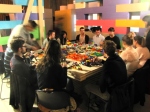February 20, 2017
 I have been reading a lot about Millennials, this new breed stemming from the digital age.
I have been reading a lot about Millennials, this new breed stemming from the digital age.
Were these Millennials so much different?
I, as a GenX, could easily relate to what I was reading and did not realise the real gap until I had the opportunity to directly compare the ways of thinking, the value systems, attitudes, and mental models, of Millennials and Baby Boomers.
The opportunity came through some workshops I facilitated to explore how customers felt about brands and their experience as consumer and shopper.
I decided to run the workshop using Lego Serious Play, a facilitation method that asks participants to build metaphorical models with Lego bricks to answer specific challenges and questions.
The method is based on narratives and storytelling, and participants are the only one who hold the interpretative keys to decode the metaphors and stories kept in their model. After building their model to answer the question, participants share their stories and their models with everyone, explaining the meaning of their models and sharing their views and perspectives on the issues I was investigating.
read more »
Posted in cocreation, CX, LEGO SERIOUS PLAY, Legoview, Methodology, Organisations |
3 Comments »
May 20, 2016
The relationship between business and design has gone through deep changes in the past years. We are assisting at a convergence between business and design lead by the formalisation and adoption of design thinking and the revelation that good design is good business: many approaches from design have migrated into business and management enhancing the potential of business focused companies.
But there is a very special case of a method that was developed as an answer to a business need that has successfully migrated to design practices.
This is the case of Lego Serious Play: developed from the ’90s to improve the quality of strategic development meetings it has now been adopted by design companies to enhance creative processes, collaboration among different department, promote co-creation and participative design that includes customers, users, designers, and stakeholders.
Presented at #CassCreativity Seminar series on May 4th 2916, you can watch the whole Storyfy from this Link.
Posted in cocreation, Methodology, Organisations |
1 Comment »
March 7, 2016

Markets are conversations (C) P. Bertini
One of the biggest challenges today, is to deliver meaningful experiences that create value to brands and are valuable for the users. As UX and CX professionals we are today responsible for the value generation processes, because an experience is created by the understanding of what does value mean for all those involved in the experience: the brand and the users.
I recently gave a speech at UX Denmark 2016, the theme was trust & emotion. If trust is the willingness to take risks, where does trust come from and how can it be useful in the UX field? Trust is generated by interaction, there is no trust unless the parts have had – or are in the conditions of having – an interaction that can build and support a relationship that generates positive emotions.
Interaction generates trust and relationships, and relationships generate experiences, and experiences are the real value in the experience economy.
Therefore, if relationships are the (metaphorical) places where value is generated between the interacting parts, then the only way to be in a relationship is through an EXPERIENCE.
Experience is generated by experiences, and the design of future experiences requires imagination and the understanding of the perception of the present experiences through narratives and storytelling of the past.
read more »
Posted in cocreation, Methodology, Organisations, ux |
1 Comment »
February 12, 2016
Recently I have spent time reading and considering the future of UX and how recent research are affecting our understanding of our cognitive experiences and our perception.
I still had no chance to organise my thoughts into a decently structured article and explain what I see happening in the future. But if you are keen to know more, Marek Pawlowsky, the man behind MEX, invited me to talk about what’s boiling… And the result is a long chat (approx from min 40′) about Lego Serious Play, principles of embodied cognition and evolving research methods for the next generation of digital experiences.
Posted in cocreation, LEGO SERIOUS PLAY, Methodology, Podcast, ux |
Leave a Comment »
May 17, 2015
In March 2015, I was challenged by Marek Pawlowsky from MEX to do something unique to inspire the UX designers’ community and to show them the potential of Lego Serious Play.
Marek is not a novice, being a participant into one of my past workshops, and the challenge was exciting enough for me to accept it!
The goal of the session was to inspire, entertain, make the audience curious, intrigue them, challenge their ordinary ways of thinking, introduce them to new ideas, theories and opportunities.
I’ve imagined how would a speed dating with LSP look like and this is what happened…! (more in the next page)
Patrizia Bertini demonstrates Lego Serious Play and considers creative methods for future experience design from Marek Pawlowski on Vimeo.
read more »
Posted in Events & Fun, LEGO SERIOUS PLAY, Methodology, theory, ux, Video |
Leave a Comment »
December 21, 2014

Cocreation brings together individuals
[Excerpt. The full article is available on UXBooth. Many thanks to Marli Mesibov].
“In the past decade, new technologies ranging from Twitter to customer service chat-windows have led to an increase in the quantity and quality of interactions between people and organizations. But listening to user feedback isn’t where the company-user interactions end. Today more than 50% of Fortune 500 companies have made co-creation an integral part of their innovation strategy, as Andrew Welch—Chief Executive Officer of Y&R reports.
Yet in user experience design, most organizations take a traditional approach to user research and design, using a researcher to act as a middle-man between users, designers, and business stakeholders. Users are consulted in the process, but not given creative control over solutions.
read more »
Posted in cocreation, LEGO SERIOUS PLAY, Methodology |
1 Comment »
November 15, 2014

Facilitation’s thorny issues
Facilitating is an art. it requires a mix of personality traits, like the ability to guide and lead a group, a set of knowledge about group dynamics, psychology, and techniques.
A facilitator is usually an external member, someone who enters into a group and guides them through a journey to get to a goal. The design part is the key: a facilitator always needs to know exactly where the group is, the next steps, the timing of every activity and include any eventual recovery plan in case something does not goes according to the plans.
Facilitator’s personality is another essential factor: the facilitator needs to be able to engage and lead the group, mitigate power games and dominant personalities and to involve shy and silent people without putting pressure.
All is clear, until the facilitator faces a challenge: facilitate within a group they know well.
read more »
Posted in LEGO SERIOUS PLAY, Methodology, theory |
1 Comment »
June 20, 2014

© Patrizia Bertini
In the past few years, the number of articles published around Lego Serious Play is hugely increased.
The initial theories developed in the mid ’90s, 20 years ago, by Johan Ross and Bart Viktor and put into its current shape by Robert Rasmussen, are today converging and mingling with new trends and emerging needs.
What was supposed to simply be a language, communication tool, problem solving methodology, based on the belief that everyone can contribute to the discussion, the decisions, and the outcome, it has become a tool for exploring, both a crinkly and torn treasure map to be completed with the imagination of the facilitator and the participants, and a hammer to deconstruct and construct new opportunities.
read more »
Posted in LEGO SERIOUS PLAY, Methodology, theory |
3 Comments »
June 12, 2014

I recently had the pleasure of facilitating a LEGO SeriousPlay workshop at Foolproof with Hot Source members. One of the participant, Marek Pawlowski, shared his experience.
As a facilitator, used to describe the method, it was refreshing and an immense pleasure to know that he experienced exactly what I always described when I talk about the power and benefits of LSP. Thank you @Marek for such an amazing post!
Improvement requires change, whether that happens gradually through iteration or in big leaps through sudden sparks of creativity. This is true of improving anything, from companies to individual products. It’s something I think about a lot in the context of the MEX initiative, which is, at its heart, about helping people to improve digital experiences. We are always looking for new ways to equip people to make good changes to the user experience of the products they’re designing.
read more »
Posted in LEGO SERIOUS PLAY, Methodology, Organisations |
7 Comments »
May 30, 2014

Co-creation: A Lego Serious Play Workshop
User centred design (UCD) is an approach that considers the user as the central point of any design process. UCD projects traditionally implied a preliminary study of users to collect their needs and requirements: a lot of efforts were made to understand users’ expectations, behaviours, frustrations, problems and generally the research approaches involved interviews, ethnographic studies, questionnaires, surveys, or focus groups.
Collected data would then be analysed by experts who would eventually come up with user requirements: a list of issues that designers should take into consideration during their design and implementation phase.
read more »
Posted in cocreation, Methodology |
1 Comment »
 I have been reading a lot about Millennials, this new breed stemming from the digital age.
I have been reading a lot about Millennials, this new breed stemming from the digital age.







